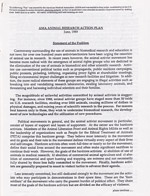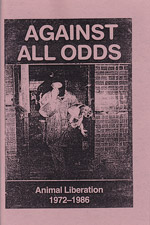The Liberator
The Liberator (1988, San Bernadino, CA. USA.)
In the 1970s, a small group of activists in England decided that animal abuse was so intrinsic to their society, and so protected by the courts and law enforcement, that anonymous, illegal activity was the only surefire way to directly prevent the horrors taking place in slaughterhouses, labs, and killing fields. They began to take the personal initiative to raid and sabotage places where the victimization of animals occurred, but how could they spread their message and tactics? With mainstream media treating them either as misguided nutcases or vicious criminals, and with national animal organizations disavowing their actions, they needed a mechanism to defend their tactics and share their views. The answer was the Animal Liberation Supporters Group, more commonly known as “The SG.” The SG soon took on the responsibility of printing newsletters, conducting press interviews, and raising funds and support for imprisoned activists. Soon, other supporters groups blossomed internationally, and eventually one took off in a small town in Southern California.
The Liberator was a publication of the Animal Liberation Front Support Group of America, an organization with a storied history that included FBI harassment, raids, and internal conflict. This inaugural issue was largely produced by Rod Coronado and Todd Meszaros, and the aesthetics of the issue reflect a bit of the punk influence that the two of them embraced. The design is busy, but also packed with information, press clipping, letters, debates, a timeline of US actions, and historically important letters from figures such as ALF co-founder Ronnie Lee. The centerfold is gorgeous, and it, and many of the other images contained inside were heavily borrowed and reprinted by other magazines.
The mission of the ALF SG of America was to vocally support and defend the ALF, to unify supporters of underground animal activism, to educate the public as to need and rationale of direct action, to encourage implementation of clandestine tactics, to provide a legal defense fund for imprisoned or arrested ALF activists, and to raise funds for all of the above. They did this at a time when dozens of labs across the country were being raided, thousands of people were protesting for animal rights, and the US seemed to be on the cusp of a mass movement for non-humans. The Liberator documented these efforts and is a classic piece of animal liberation history.





